
There are twelve species of Juniper Tree and Shrub native to The United States, though the most common are the Spartan Juniper, Hollywood Juniper, and Juniper Wichita Blue. The Tree Center offers carefully chosen Junipers, which will ship quickly to most locations throughout the United States. Then, carefully read the specifics about planting and caring for Juniper Trees in the proceeding sections. Read about the essential facts on the Juniper Tree below. Juniper Trees are adaptable to sunny and drier climates, and they are perfect property privacy protectors and shade providers. It is essential to learn about the Juniper Tree before planting a new sapling, as the tree’s needs, the effort on the part of the planter, and the benefits and concerns around any new tree change from species to species. In USDA hardiness zones 3 through 10, Juniper Trees can offer shade, privacy, and adaptability. For this reason, Junipers may be called redcedars or whitecedars, the lack of space noting the inherent difference between these and true Cedars. Oftentimes, Junipers are commonly referred to as Cedars, though true Cedars fall under the genus Cedrus. The other most common species are the Spartan Juniper and the Hollywood Juniper. There are 12 species within the genus Juniperus which grow well in the United States, including the privacy screen or hedge known as Juniper Wichita Blue. These evergreens can reach as high as 130 feet tall, though some varieties offer low ground-cover instead. Juniper Trees are native to several regions throughout the world, including North America, Africa, Central America, and Asia. With every size, from a low-shrub to a tall tree, Junipers will fit the needs for most homeowners. Avoid planting your Junipers too closely to sidewalks, structures and power lines, especially if the mature height and width are larger.Juniper Trees are diverse, with between 50 and 70 subspecies. Either season is fine, provided the ground near your Junipers is not frozen.Īlso, it's important to keep spacing in mind. Generally, we recommend planting your Juniper Trees in early spring or in fall.

Finish by watering the surrounding soil near your Juniper and mulching to conserve moisture.

When you're ready to plant, select an area with well-drained soil, dig a hole large enough to accommodate the tree’s root ball (along with some extra width for mature growth), place your Juniper and back fill the hole. Your fertilizing and pruning needs will vary as well, but many of our Junipers do not require pruning.

SKYROCKET JUNIPER HOME DEPOT FULL
Most will prefer full sun (anywhere from 6 to 8 hours of sunlight per day) and well-drained soil, but make sure you check your tree's specific directions. After you’ve determined your growing zone, keep sunlight and watering needs in mind for Juniper Trees. Specific directions will vary, but knowing your growing zone is important. Though it is important to determine your growing zone and select the perfect Juniper for your area, most of our Juniper Trees stand up to the elements effortlessly. Juniper Trees grow nearly anywhere across the country. This forgiving variety will reward you with hassle-free greenery for years to come.Īnd many Juniper Trees have dense foliage as full and green in the depth of winter as in mid-summer, so it’s perfect for places where you want a little coverage all winter long. If you’re interested in spending more time enjoying your yard and less time caring for it, Juniper Trees are a perfect choice.


 0 kommentar(er)
0 kommentar(er)
